Contents: Identification, Interesting Facts, Distribution, Diet, Nesting Behavior, Offering Feathers, Nestboxes, Monitoring, Nesting Timetable, Deterring TRES, and More Info. Also see Photos of nests, eggs and young; dead TRES found in nestboxes and How to Make Kerfs.
Tree Swallows (Tachycineta bicolor), or TRES, are beautiful, acrobatic, brave birds. These migratory birds also eat lots of insects.
Identification: Adults have dark blue iridescent feathers on their back, with a snow white throat and breast (tuxedo birds!) Males and females look alike, although females may be a little more greenish. Some adults are drab gray. They look like they are wearing a tuxedo. Their wingtips reach the tip of their tail; they do not have a long, scissor/forked tail like Barn swallows. In contrast, the Violet-green swallow (Tachycineta thalassina), which is found only in the West, is smaller, has emerald and violet above and white cheek patches extending over their eyes, and their wingtips project well beyond the tips of their tails. Juvenile Tree Swallows (May-September) have a uniform gray-brown upper side, and a pale grayish breast band.
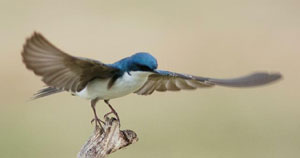
- They eat, drink and bathe on the fly (their legs are not very strong.) They dip down and hit the water over and over.
- They may be seen picking up grit on the ground (and nesting material of course.)
- They will “play” with feathers used to line the nest (dropping and re-catching them in flight.)
- Males develop a brood patch and may help incubate eggs.
Distribution: All across the continental U.S. (except the southeastern corner) and Canada, and in parts of Alaska. See distribution maps.
Overall, there are 86 species of “swallows.” Tree swallows are in the Tachycineta genus, which is from the ancient greek takhukinētos meaning “moving quickly.” Nine Tachycineta species are found in the Americas. In addition to the Tree Swallow, Violet-green Swallows also use nestboxes.
Diet: During breeding season, TRES feed on flying insects. They may travel 20 miles or more to forage.
According to veteran birder Dick Tuttle (NABS Bluebird Journal, Winter 2006-2007)
- Each adult Tree Swallow will consume about 2,000 insects per day during an average 45 day nesting period
- The parents also catch and feed their brood (of 4-7 nestlings) about 6,000 insects per day during an average 20 days spent inside the nestbox.
- This adds up to an estimated 300,000 insects per TRES nesting family:
- 180,000 insects for the nesting pair (2,000/day/adult x 45 days)
120,000 for their nestlings (6,000 insects per brood x 20 days)
- 180,000 insects for the nesting pair (2,000/day/adult x 45 days)
- Since 90% of their hunting takes place below 39 feet, TRES can make a real dent in insect populations that pester humans.
Since TRES rely on insects caught on the wing, extended periods of cold rain can be deadly because of reduced insect activity during such weather.
TRES do eat berries in the winter and during migration, and possibly when insects are unavailable. 90% of the fruit they consume is from bayberry/waxberry [Myrica carolinenses] and Wax Myrtle [Myrica cerifera), according to Beal, 1918. Not many birds (especially other aerial insectivores) can digest the waxy coating of these fruits.
Tree Swallows do not eat birdseed, nor will they come to a mealworm feeder. However, a few people have gotten hungry TRES to take crickets or mealworms flung into the air. Breeding TRES may also pick up grit or eggshells from the ground.
Obviously, a single mosquito wouldn’t make much of a meal. In addition, delivering one tiny bug at a time would be time consuming. Instead, parents often pack captured insects into a BB-sized ball called a “bolus,” which they bring to their young. Dick Tuttle indicated each bolus contains an average of 18 insects, 99% of which are smaller than one centimeter.
TRES also drink and bathe in flight. They dip down and hit the water over and over. From a distance, it looks like a stone skipping across the water’s surface. A flock of acrobatic swallows skimming the water at sunset is quite a sight to behold.
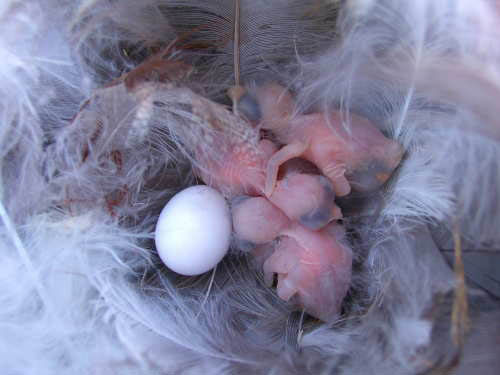
Nesting Behavior: Like bluebirds, TRES are secondary cavity nesters, meaning they depend on pre-existing nest sites like nestboxes. Although they’re very social, they’re also territorial with their own species. Later in the nesting season, they defend a smaller area. They have been seen removing eggs from a chickadee nest.
Offering Feathers: TRES may snatch, “play” with and chase feathers thrown into the air or left on the ground. Use undyed (unbleached is okay), 1-3″ long, clean, soft light-colored feathers that have not been treated with chemicals. Cut off any stiff pointy quills. Stand about 20 feet from the box, and loft the feather into the air. Both the male and female will chase after it and take it to the nest. Often one will seem to play by dropping the feather in air for the other to catch. Eventually TRES may even take feathers from your hand. Offering clean feathers probably helps reduce mites in nests.
- Type: TRES will nest in bluebird nestboxes. Some guidelines recommend: 5 x 5″ floor, 5.5″-6.0 depth, a 1.5″ hole or Peterson oval hole 1.375″ x 2.250″, 10-12′ off the ground (they will nest in boxes 4-5′ high).
- Kerfs: Boxes that Tree Swallows nest in should have “kerfs” or grooves below the entrance hole to enable fledglings to exit, especially if the box is deep! See more info.
- Floor Size: They prefer large floor areas over small (e.g., 6×6″ over 4×4″), and shallow (4.7″) over deep (6.5″) boxes (Lumsden 1986). Dick Tuttle’s research review found that feather growth of young in 4″ PVC nestboxes was stunted compared to young raised in larger floored wooden nestboxes (NABS, Summer 2007.) They may lay a smaller clutch in a small box. Wing lengths on birds in clutches of 6 or more may be shorter upon fledging from a crowded box, which could affect survival (Stewart 1999).
- Style: On my trails seem to prefer Peterson boxes. Others have reported they like Troyer slot boxes. Occasionally they nest in a Purple Martin house. It’s possible they may not prefer a Bitner box? TRES picked a Zuern Tree Branch box over NABS/Chalet at a friends house.
- Hole Shape: Some people use an oval hole, or a sideways (flattened) diamond.
- Hole Size: They will use a box with a standard 1.5″ round hole or an oval hole 1.375 x 2.250.” Tree swallows may not be able to enter a hole smaller than 1 3/8″ per James Kronenberg.
- Distance and Pairing: Many people place TRES boxes 90-100 feet apart. TRES will nest in boxes that are over 20 feet apart. (Generally they nest at least 33-50 feet from nearest neighbor (Robertson and Rendell 1990). Nesting pairs occasionally breed only 3 to 8 or 10 feet apart (Harris 1979, Boone 1982). I had a pair nesting 9 feet 10″ apart. Dottie of Brown County had TRES with nests (and some with eggs) in all 12 compartments of a Purple Martin house but the nests were all abandoned. If nesting bluebirds are harassed by Tree Swallows, or more than 50% of bluebird trail boxes are occupied by swallows, try setting up a second, “paired” box 5-20 ft. away from the first. TRES may help defend both boxes. See more about Pairing.
- Location: TRES may prefer boxes that are in an open field (better maneuverability), up to 109 yards from forest edge (maybe to avoid House Wren predation), and near water (but not on the water’s edge, as this area is frequented by raccoons). They may use the same box year after year, even if it is repeatedly vandalized.
- Direction: Tree Swallows prefer entrance holes facing South vs. North (Lumsden 1986). Others say they prefer boxes facing Northwest or East.
- Roof: Jane Brockway indicated that swallows prefer a “straight shot” into a box, so a box with a longer roof with a lip under it (so the birds have to go under and up to get into the box) may deter TRES. TRES like a T post mounted on top of the box for perching while guarding.
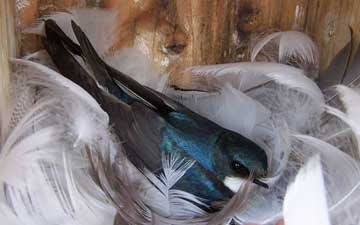
MONITORING: Do not disturb nestboxes after nestlings are 15 days old, to avoid premature fledging. (You may be able tell the age because the parents stop removing fecal sacs when they are 14 days old). Tree Swallow adults are generally tolerant of humans and monitoring. One Cornell researcher said “It would take a sledge hammer to make a Tree Swallow abandon a nest.” Sometimes incubating females refuse to leave the nest, even if the nest is taken out of the box.
However, they can also be quite territorial, and may not like it when humans approach the nestbox, and may swoop, dive bomb, click their beaks and make a racket. (I saw a photo of TRES attacking a snake trying to climb the nestbox pole.) Neighboring TRES may gang up to bomb monitors (e.g., 6 at a time), especially if eggs are in the process of hatching. The only time I ever heard of a monitor being hit by a TRES was an accident – he leaned down to pick something up, and then stood up and the TRES connected. Bruce Burdett of the NH Bluebird Conspiracy said “I have been dive-bombed a million times by Tree Swallows and I’ve never had one hit me.” All the same, it can be a disconcerting, and some monitors wear a hat or carry a broom or stick their hands over their heads to avoid a collision. Try to monitor the box quickly and quietly to minimize stress. If boxes are monitored regularly, they usually adjust, and aggression may lessen after the babies hatch.
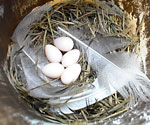
Do NOT pick up females that won’t budge – they can clutch eggs with their feet which then drop and break, or young which if they fly out of the box can fall to the ground.
It’s a good idea to clean the box out with diluted Clorox when nesting is over. Avoid touching the nest as it may have bird mites – instead put it in a plastic bag and dispose of it in the trash. TRES nests often get blow flies.
NESTING TIMETABLE (typical – dates are for Northeastern U.S.):
- Arrival: Males arrive first, females a week later. They migrate long distances, and some people believe that dead TRES found in a nestbox early in the season may have been overcome by exhaustion or starvation. 13-70% of adults return to their former breeding territories, depending on winter mortality and previous breeding successes. On average, females chose to breed 5.2 miles from where they hatched, males 1.5 miles. The same nest site may be reused, with a new nest built on top of the old. I have seen over a dozen birds fighting over one nestbox by a stream. In some areas, TRES are beginning nesting earlier than they have in the past, which increases competition with bluebirds.
- Nest Construction: Nest building begins in end of April-early May (sometimes 5 to 6 weeks after arrival.) It can take 2-4 weeks, and is done only by the female, and usually only during the morning. Tree Swallows spend a lot of time checking out and peering into a box. It seems like they put one piece of grass a day into the box! The nest is made of grass (sometimes coarse) or pine needles. The nest can be sort of sloppy. The cup, which is flatter than that of a bluebird, is lined with feathers (although I have seen a couple without feathers) most of which are added after egg laying begins. Downy feathers are often used in the cup, encircled by larger feathers that curl up over the eggs for insulation. Occasionally trash or bits of white birch bark, paper, tissue or cloth are used. Once the nest is feathered, it is rarely abandoned. If you want to speed up nest building, leave some dried grasses nearby.
- Egg Laying: Late April to Mid-May: One egg is laid each day (sometimes adults leave the nest for days between if they go far away to forage), with 4-7 eggs per nest. Egg laying is usually (but not always) synchronous – i.e., within 7-10 days of neighbors. Eggs are pure white (occasionally they have a pinkish tinge when first laid) and pointy on one end. Older birds may lay more eggs? A study by Dunn and Winkler indicated that from 1959-1991, TRES laid their eggs about 9 days earlier by the end of this period, perhaps due to climate change. Because they spend so much time away from the nest during construction (and while feeding), they are very vulnerable to House Sparrow attacks. However, they will tolerate a Sparrow Spooker.
-
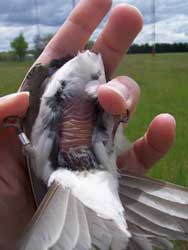
TRES brood patch. Photo by Torrey Moss. Incubation: lasts 14 – 15 days (11-19 possible). It starts the day the next to last egg is laid. If it is cold out, the start of incubation could be delayed for up to two weeks. The female often sticks her head out of the hole and looks like a little orca. Males guard the nest and may also incubate.
- Hatching: Fertile eggs generally hatch within 1-2 days of each other. Bad weather can lengthen hatching period. Females brood the babies (see photo of a brood patch right by Torrey Moss) for 3 days, and then only at night or when it is very cold (up to 10-11 days). In my experience, TRES rarely remove unhatched eggs from their nests.
- Development: The parents pack insects they catch into a BB-sized ball called a bolus, and bring them to their young. Fecal sacs may be dropped in bodies of water
- Fledging occurs 18-22 days (15-25 days possible) after hatching.
- After Fledging: Fledglings can immediately swoop like experts. The parents seem to guide and “dance” with them, chattering away. Fledglings can feed themselves (which is probably why they stay in the box longer – to gain weight and strength), but may get an occasional feeding by parents during the first 3 days, unlike bluebirds which beg parents for up to four weeks after fledging. One person reported seeing newly fledged TRES trying to go back into their box while other babies were still in it. Some have reported TRES juveniles from other nestings entering and exiting different boxes, without harming the nestlings. There is a concern that these juveniles may be stealing food destined for nestlings. Both nestling and fledging Purple Martins may practice piracy.
-
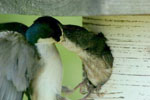
Tree Swallow feeding young. Photo by Wendell Long. Dispersal: Eventually, females generally disperse about 5 miles from the box they fledged from, and males about 1.5 miles on average. They start migrating towards their winter range in July-August. PIRACY: Professor Mark Stanback reported piracy in a nestbox, where a banded fledging entered another parent’s nestbox to be fed. (This does happen with Purple Martin young.)
- Number of Broods: Tree swallows almost always only have one brood per nesting season. This is probably because groups migrate together, lay synchronously, have a long nesting cycle (it takes them a long time to build a nest, and young must be ready to fly and feed themselves upon fledging), and migrate away as a group. Normally they would only lay a second clutch in response to disturbance or failure of the first brood. It is also possible that what appears to be a second brood in the same box is really another bird/pair that couldn’t find a nesting spot when their neighbors were nesting, or had a failed first brood elsewhere.
- Cornell indicates that second broods are extremely rare, although I believe several may have occurred on my trail in CT in 2004, where they apparently began immediately after fledging. But without banding, it is impossible verify that the same parents nested.
- A banding friend had a second brood in a different box by the same female. (Unfortunately I can’t remember who this was!)
- Paula Ziebarth of Ohio has seen two successful nestings in a row in the same box, but again, without banding, cannot tell whether it is the same female. She does see a high percentage of first year females nesting on the second go-around, so perhaps were not experienced enough to compete for a box the first time around.
- Reports of two clutches by Wedemeyer 1934 in Montana.
- B. Frohman of Modesto California reported two successful broods in the same box in 2015 and also one other year, but again could not be certain the same adults were nesting twice in one year.
- One report of three clutches (Loftin and Roberson 1983), but first two did not hatch.
- (Unlike bluebirds, I’d recommend leaving the nest in place after fledging for a week or two just in case.)
- Professor and bird bander Mark Stanback, who monitors 649 boxes in NC has had immediate re–nesting in 1/4 to 1/2 of TRES nests. Banding would confirm the same females are laying.
- Some trail monitors prefer bluebirds over other native cavity nesters, and are concerned when TRES “take over” their boxes and their trails, mobbing and out competing other birds. Please note:
- TRES are beneficial, native birds, and it is ILLEGAL to harm their eggs, young or adults, or to interfere with their nests. One monitor shared that a couple was using glue traps and BB guns to try to “defeat” TRES. This is actually a criminal violation of the federal Migratory Bird Treaty Act. (Plus, what would you do if a bluebird got caught in a glue trap? They are inhumane, and it is almost impossible to free a bird from a glue trap and have them survive. DO NOT USE glue traps EVER in a nest box.)
- Diversity on a trail (a variety of native species nesting) makes things interesting, and is healthy for the ecosystem.
- Aerial insectivores like TRES are in decline generally (probably due to loss of habitat and pesticides) and need your help too.
- If you DO wish to deter TRES in favor of other native species, here are some suggestions:
- Space boxes far apart – e.g., 150-300 yards. Some monitors have found they get more bluebirds nesting this way.
- Locate boxes away from water, as TRES like to hunt, bath and drink in rivers, lakes, etc.
- Try pairing boxes 5-20 feet apart.
- Try NOT pairing boxes (and definitely don’t put them farther than 5-20 feet apart, as TRES may take both boxes if they are more than 25 feet apart.
- Use boxes that have a longer roof with a lip under it so birds have to go under and up to reach the entrance hole.
- If you are seeking smaller species (chickadees or titmice) use a hole guard/reducer that makes the hole too small for TRES.
References and More Information:
- More photos of TRES nests, eggs and young
- Asynchronous hatching photo showing variable sizes of young in one nest
- Pairing Nestboxes when TRES populations are high
- Grid set up for nestboxes
- Tree Swallow educational site – Tree Swallow Projects: comprehensive info on nestboxes, site selection, banding, record keeping, etc.
- Tree Swallow: Cornell Birdhouse Network bio
- Nest and egg ID (this website)
- Nestbox plans | NestboxBuilder
- Cornell Nestbox Cams– may have TRES
- Violet-green Swallows: All About | Photos of nests, eggs and nestlings
- Hilarious TRES video clips by The Bluebird Nut
- Nest and Egg ID (with links to species biology and photos of nests, eggs and young) for other small cavity nesters
- Loftin RW and Roberson D, Infanticide by a Purple Martin, The Wilson Bulletin, Vol.95, No.1 (March 1983), pp.146-148
- Premature fledging
- TRES nestling choked on bug
- Competition among species
- Migratory Bird Treaty Act
Some interesting notes:
- Amy Marr of Greenfield, Indiana reported that she found an immature tree swallow dead in a nestbox that held another TRES pair’s set of eggs.
- Another monitor in her area found a full-sized TRES juvenile (possibly a second year bird? Had a grey back) hunkered down in a nest cup with five to six day old bluebird babies, possibly freeloading. A nearby box of tree swallows had fledged a few days prior. The monitor picked up the tree swallow, which sat quietly in her hand and then flew off.
- I’ve seen Tree Swallow nests without feathers, some with grass seed heads (which are more typical of House Sparrow nests), some that are almost as neat as a bluebird nest, others that are really sloppy, some of all pine needles, and this year one with a big burr in it. Shari Kestner of WI reported one made of maple tree seeds and grass.
- Vicki Butler of CA found that TRES did not use hanging nestboxes with a branch shielding the entrance hole.
Photographs: Top photo and feeding Tree Swallows by Wendell Long, others by Cherie Layton. Brood patch by Torrey (Moss) Wenger.
It is almost as if they live to fly, rather than, as most birds, fly to live.
– Robert R. Cohen, Sialia, 1984
